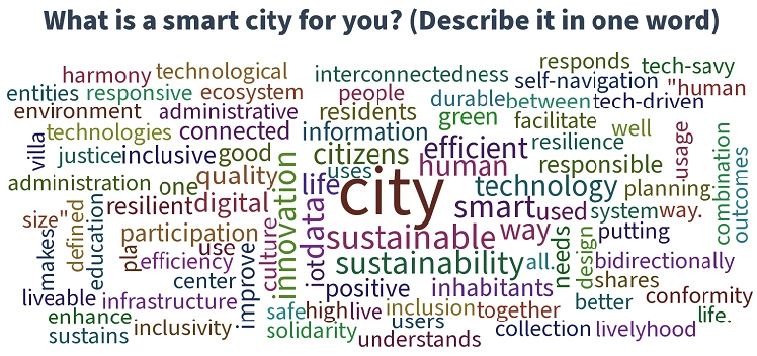 Word cloud containing words used in the blog, such as "resilient" and "sustainable" and "data."
Word cloud containing words used in the blog, such as "resilient" and "sustainable" and "data."
What is a smart city? We’ve heard the term in contexts as diverse as urban planning and governance, transport, energy, the environment, health, and education. We’ve also noticed that the notion of smart cities relies on a range of technologies—including the internet of things (IoT), mobile solutions, big data, artificial intelligence (AI), and blockchain. Because of this connection with technology, we’ve had concerns about how smart cities will address issues such as data privacy and social exclusion. We see a risk that urban areas with poor web connectivity could be left out of the smart-cities trend. We’d like to continue an open dialogue on this trend.
At the World Bank’s Global Smart City Partnership Program, we held a Virtual Knowledge Exchange Program on Smart Cities for Sustainable Development, jointly organized with the World Bank’s Open Learning Campus, to discuss the trend. At the event, we polled more than 260 participants from around the world to find out what they thought a smart city would be, what makes a urban area and its citizens smart, and what they wanted to see in their own smart city. As the word cloud shows, “technology,” “innovation,” and “connection” were the first words that came to participants’ minds when they thought of smart cities. “Citizen participation” and “data” make a community and its citizens smart, according to most of the participants. Around half chose “sustainability” as a priority in their vision for a smart city, and a quarter voted for “resilience.” We asked our panelists similar questions; here are five takeaways.
Michael Donaldson, Chief Technology Officer of the City of Barcelona, said that he has seen a shift in the understanding of smart cities from associations with data and technology to a layered definition embracing “citizen intelligence” and “humanizing technology.” Barcelona’s digital participatory platform enables citizens to help direct city management by suggesting ideas. “Citizens have a lot of experience about the city, and we need to gather this intelligence in order to make better decisions,” he said.
Alice Charles, Head of Cities and Real Estate at the World Economic Forum, noted the changing role of the private sector in smart cities from “selling widgets and gadgets to the cities” to “promoting an outcome-driven model.” Companies are focusing on technologies that help urban leaders achieve their goals. This model requires stronger partnerships among cities, the private sector, civil society, and academia. Examples include the Smart Cities Challenge by Infrastructure Canada; City Possible, by Mastercard; and the Helsinki Energy Challenge.
Martin Weiss, Professor at the University of Pittsburgh, sees an opportunity in the wake of COVID-19 to find out what alternative smart worlds would look like. Digital technology has stood out, as it facilitates remote work, private and public online service delivery, and contactless interactions. He said, “We will focus on different questions than before, like how we make access to high-speed services less dependent on heavy infrastructure investments.”
Pedro Vidal, Intelligent Transport Systems Coordinator at the Chilean Ministry of Transport and Telecommunications, said that the pandemic hit mobility and public transportation services hard. “We have made alliances with universities to understand behavioral trends and are convinced that there are some changes in mobility preferences,” he said. “We created lanes for bicycles and developed measures for using public spaces in a safe way. We have seen an increase in the use of public transport. This can be transformed into a big opportunity to have a more sustainable city.”
Rudi Borrmann, Deputy Director at the Open Government Partnership (OGP) Local, emphasized the importance of openness and transparency in gathering and using data for public services, especially during the pandemic. He said that the first step toward creating a smart city is for local governments to improve the way they coordinate and communicate transparently with stakeholders. “Openness needs to be at the center of creating trust in bringing solutions to the citizens by using technology,” Borrmann says. OGP recently started the Open Response Recovery Campaign, in which the partnership developed a series of recommendations on how to better use open government as a way to strengthen trust during the pandemic.
All told, it looks as though a smart city is one that uses technology to efficiently engage citizens and meet their needs. In the post-pandemic era, we must prioritize measures to address inequality and digital divides, which leave many of the poor, and poor cities, behind. Data privacy and transparency must be protected. Cities become smarter when citizens and communities use technology to coproduce an environment where their digital rights are protected and their cities are made more sustainable.
Watch the recording of the full discussion here.



Join the Conversation